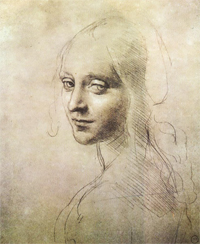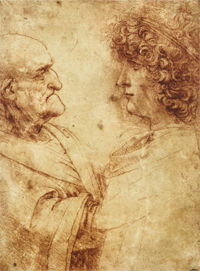Muscarelle announces Leonardo da Vinci exhibit for 2015
The Muscarelle Museum of Art at William & Mary will host an exhibition devoted to Leonardo da Vinci’s fascination with the beautiful and the ugly Feb. 21 to April 5, 2015.
Leonardo da Vinci and the Idea of Beauty will comprise more than 25 outstanding drawings by the Renaissance genius, including the precious sketches in the “Codex on the Flight of Birds” and the delicate “Study for the Head of an Angel,” described by Sir Kenneth Clark as “one of the most beautiful drawings in the world.” The show will also include a newly discovered self-portrait of Leonardo at age 53, to be exhibited for the first time in the United States at the Muscarelle.
 Visitors will be afforded a unique opportunity to explore the sources and influence of Leonardo’s philosophy of beauty as revealed in an unprecedented concentration of his drawings, lent from the Uffizi museum in Florence and the Biblioteca Reale in Turin, Italy, and as contrasted with eight original drawings by his greatest rival, Michelangelo Buonarroti, specially selected from the Casa Buonarroti in Florence.
Visitors will be afforded a unique opportunity to explore the sources and influence of Leonardo’s philosophy of beauty as revealed in an unprecedented concentration of his drawings, lent from the Uffizi museum in Florence and the Biblioteca Reale in Turin, Italy, and as contrasted with eight original drawings by his greatest rival, Michelangelo Buonarroti, specially selected from the Casa Buonarroti in Florence.
Organized by the Muscarelle Museum of Art, the exhibition was conceived in partnership with the Museum of Fine Arts, Boston, which will be the second and only other venue for the exhibition. It will be on view in Boston from April 15 through June 14, 2015.
Leonardo da Vinci and the Idea of Beauty is the second major Renaissance exhibition shared between the museums in the American Colonial capitals of Williamsburg and Boston, following on the acclaimed success of Michelangelo: Sacred and Profane, Masterpiece Drawings from the Casa Buonarroti in 2013.
The theme of beauty was the abiding concern of the Italian Renaissance in both art and philosophy. Leonardo da Vinci was almost obsessed by the constant contrast between beautiful and ugly (bello e brutto) in the visual world. Unlike Michelangelo, who was an idealist, Leonardo found a hidden beauty even in the most unsightly of faces. In this sense, he foreshadowed the painter Caravaggio, who is known to have studied his texts. In Leonardo’s Treatise on Art, nature is constantly cited as the ultimate authority, a synonym almost, for "divine."
"Perhaps the emblem of this groundbreaking exhibition is the famous drawing from the Uffizi which represents an 'Old Man and Youth Seen in Profile.' This image encapsulates Leonardo’s obsession with the relentless natural destruction by time with beauty,” said Aaron De Groft, director and CEO of the Muscarelle Museum of Art. “Two great scholars, Bernard Berenson and Sir Kenneth Clark, regarded this drawing as one of Leonardo’s most intriguing of drawings, and Clark regarded ‘Study for the Face of an Angel’ – the star of our exhibition – perhaps ‘the most beautiful drawing in the world.’”
'The Codex on the Flight of Birds'
Leonardo da Vinci recorded countless observations on nature, biology, geology, and physical science on manuscript pages that are now mostly lost. Of the roughly 20 bound manuscripts – or codices – that have survived, his Codex on the Flight of Birds is considered one of the most influential. A complete codex, or early book, is so rare that fewer than 20 written by Leonardo remain in the world today.
 Leonardo da Vinci has long been credited with some of mankind’s earliest progress towards human aviation, and he is often cited as an informational and inspirational source for the Wright brothers. Leonardo wrote more than 35,000 words and created more than 500 sketches dealing with flying machines, the nature of air and bird flight. Perhaps the most notable of these musings, the Codex on the Flight of Birds, will be an integral part of this exhibition. Visitors will be able to flip through the entire codex electronically while viewing entries specifically chosen by the curator. The codex is rarely displayed outside of Italy.
Leonardo da Vinci has long been credited with some of mankind’s earliest progress towards human aviation, and he is often cited as an informational and inspirational source for the Wright brothers. Leonardo wrote more than 35,000 words and created more than 500 sketches dealing with flying machines, the nature of air and bird flight. Perhaps the most notable of these musings, the Codex on the Flight of Birds, will be an integral part of this exhibition. Visitors will be able to flip through the entire codex electronically while viewing entries specifically chosen by the curator. The codex is rarely displayed outside of Italy.
A singular rarity regarding the Codex on the Flight of Birds will be the first time exhibited in the United States the newly discovered self-portrait of Leonardo at age 53. Hidden behind his characteristic right-to-left script, the red chalk self-portrait will be revealed in this exhibition and describes how Leonardo really saw his famously handsome features.
“Leonardo da Vinci and the Idea of Beauty” has been curated by John T. Spike, assistant director and chief curator at the Muscarelle Museum of Art. A scholarly and profusely illustrated catalogue will be published with essays by distinguished authorities, including Spike, David Alan Brown of the National Gallery, and Paul Joannides, professor emeritus at Cambridge.
The exhibition has been organized in association with Associazione Culturale Metamorfosi in Rome, and under the patronage of the Italian Embassy in Washington, D.C.















